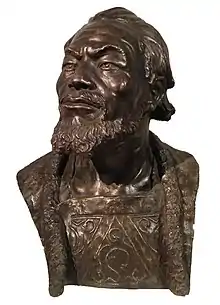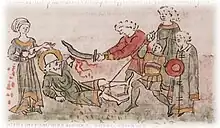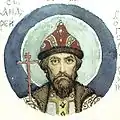Andrey Bogolyubsky
Andrew I (died 28 June 1174;[1] Russian: Андрей Ю́рьевич Боголюбский, romanized: Andrey Yuryevich Bogolyubsky, lit. Andrey Yuryevich of Bogolyubovo), was Grand Prince of Vladimir from 1157[2] until his death. During repeated internecine wars between the princely clans, Andrey accompanied his father Yuri Dolgorukiy during a brief capture of Kiev in 1149; 20 years later, he led the Sack of Kiev (1169),[3][4] and made efforts to elevate Vladimir on the Klyazma as the new capital of Kievan Rus'.[5] He was canonized as a saint in the Russian Orthodox Church in 1702.[6]
Andrew Yuryevich Bogolubsky | |
|---|---|
 Andrey Bogolyubsky. Forensic facial reconstruction by Mikhail Gerasimov. | |
| Right-Believing, Passion Bearer | |
| Born | unknown Rostov, Kievan Rus' |
| Died | 28 June 1174 Bogolyubovo, Vladimir-Suzdal |
| Venerated in | Eastern Orthodox Church |
| Canonized | 15 October 1702 (Translation), Dormition Cathedral, Vladimir by Russian Orthodox Church |
| Major shrine | Dormition cathedral, Vladimir |
| Feast | 4 July (burial), 30 June, 23 June, 10 October, 25 May |
| Attributes | Clothed as a Russian Grand Prince, holding a three-bar cross in his right hand |
| Patronage | Russian NBC Protection Troops |
Biography
Andrey Bogolyubsky was born ca. 1111, to a daughter of Ayyub Khan, the Kipchak leader, and to Yuri I Vladimirovich (Russian: Юрий Владимирович), commonly known as Yuri Dolgoruki (Russian: Юрий Долгорукий). Yuri was a son of Volodimer II Monomakh, progenitor of the Monomakhovichi.[7] Yuri proclaimed Andrey a prince in Vyshgorod (near Kiev).
Career
Andrey left Vyshgorod in 1155 and moved to Vladimir, a little town on the river Klyazma founded in 1108.[7] After his father's death in 1157, he became Knyaz (prince) of Vladimir, Rostov and Suzdal.[5] He commenced the construction of fortifications around the town of Vladimir in 1158 (completed in 1164), as well as the Dormition Cathedral in Vladimir.[7] In 1162, Andrey sent an embassy to Constantinople, lobbying for a separate metropolitan see in Vladimir.[8] Fortifications around Vladimir were completed in 1164.[3] The same year Andrey attacked the Volga Bolgars;[3] he won a victory, but a son was killed in battle, to whose memory he ordered the construction of the Church of the Intercession on the Nerl in 1165.[9]
In 1169 Andrey's troops sacked Kiev, devastating it as never before.[4][10] After plundering the city,[11] stealing much religious artwork, which included the Byzantine "Mother of God" icon.[12] Andrey appointed his brother Gleb as prince of Kiev, in an attempt to unify his lands with Kiev.[13] Following his brother's death in 1171, Andrey became embroiled in a two-year war to maintain control over Kiev, which ended in his defeat.[13]
Andrey established for himself the right to receive tribute from the populations of the Northern Dvina lands. As "ruler of all Suzdal land", Bogolyubsky transferred the capital to Vladimir, strengthened it, and constructed the Assumption Cathedral,[14] the Church of the Intercession on the Nerl,[15] and other churches and monasteries. Under his leadership Vladimir was much enlarged, and fortifications were built around the city.[16]
Death

During Andrey's reign, the Vladimir-Suzdal principality achieved significant power, and it became the strongest among the Kievan Rus' principalities. The expansion of his princely authority, and his conflicts with the upper nobility, the boyars, gave rise to a conspiracy that resulted in Bogolyubsky's death on the night of 28–29 June 1174, when twenty of them burst into his chambers and slew him in his bed.[12]
According to the story of Andrey Bogolyubsky's death as recorded in the Kievan Chronicle of the Hypatian Codex (Ipatiev),[18] and the Radziwiłł Chronicle,[17] his "right hand" was cut off[18][17] by an assailant called "Peter" (Петръ):
- Kievan Chronicle sub anno 6683 (1175 [sic]): Church Slavonic: Петръ же ѿтѧ ему руку десную. кнѧзь же вьзрѣвъ. на н҃бо. и реч̑ Гс̑и в руцѣ твои предаю тобѣ дх҃ъ мои. и тако оуспе оубьенъ же быс̑ в суботу на нощь.[19], romanized: Petrʺ že ѿtѧ emu ruku desnuju knѧzʹ že vʹzrѣvʺ knѧzʹ že vʹzrѣvʺ. na n҃bo . i reč̑ Gs̑i v rucѣ tvoi predaju tobѣ dh҃ʺ moi. i tako ouspe oubʹenʺ že bys̑ v subotu na noŝʹ., lit. 'And Peter took from him his right hand. The prince looked upon heaven and said: 'Lord, into your hands I commit my spirit.' And so was he taken away on Saturday night.'
- Radziwiłł Chronicle sub anno 6683 (1175 [sic]): Church Slavonic: Петръ ему же от(ъ)тя руку десную. И убьенъ ж(е) быс(ть) в суб(оту) на ноч(ь)., romanized: Petrʺ emu že ot(ʺ)tja ruku desnuju. I ubʹenʺ ž(e) bys(tʹ) v sub(otu) na noč(ʹ)., lit. 'And Peter took his right hand from him. And he was killed on Saturday night.'[20]
However, the Radziwiłł Chronicle's adjoining miniature depicts his assailants cutting off his left arm.[17] Moreover, when Dmitry Gerasimovich Rokhlin examined the exhumed body of Andrey Bogolyubsky in 1965, he "found a lot of cut marks on the left humerus and forearm bones".[18] A 2009 special historical study by Russian historian A.V. Artcikhovsky (2009) would later confirm Rokhlin's observations.[18]
Descendants
With his wife, Andrey Bogolyubsky had one son, Yury Bogolyubsky, who became the husband of Queen Tamar of Georgia.
Legacy
- The ancient icon, Theotokos of Bogolyubovo, was painted in the 12th century at the request of Andrey Bogolyubsky.[21]
- Andrey had the castle, Bogolyubovo, built near Vladimir, and it would become his favorite residence[16] and the source of his nickname, "Bogolyubsky".
- His victory over the Bulgars is remembered yearly during the Honey Feast of the Saviour.
Gallery
 Grand Prince Saint Andrey Bogolyubsky, by Viktor Vasnetsov c. 1890
Grand Prince Saint Andrey Bogolyubsky, by Viktor Vasnetsov c. 1890 Andrey Bogolyubsky. Forensic facial reconstruction by Mikhail Gerasimov. 1941
Andrey Bogolyubsky. Forensic facial reconstruction by Mikhail Gerasimov. 1941
See also
References
- Martin 2007, p. 112.
- Martin 2007, p. xv.
- Martin 2007, p. xvi.
- Plokhy 2006, p. 42.
- Andrew I at the Encyclopædia Britannica "Andrew made Vladimir the centre of the grand principality and placed a series of his relatives on the now secondary princely throne of Kiev. Later he also compelled Novgorod to accept a prince of his choice. In governing his realm, Andrew not only demanded that the subordinate princes obey him but also tried to reduce the traditional political powers of the boyars (i.e., the upper nobility) within his hereditary lands. In response, his embittered courtiers formed a conspiracy and killed him."
- "АНДРЕЙ ЮРЬЕВИЧ БОГОЛЮБСКИЙ". www.pravenc.ru. Retrieved 2022-05-29.
- Martin 2007, p. 92.
- Plokhy, Serhii (2021). The Gates of Europe : A History of Ukraine. New York: Basic Books. pp. 45–46. ISBN 978-0-465-05091-8.
- Martin 2007, p. 94.
- Martin, Janet (2004) [1986]. Treasure of the Land of Darkness: The Fur Trade and Its Significance for Medieval Russia. Cambridge University Press. p. 127. ISBN 9780521548113.
- "Russian Rulers: Andrey Yurievich Bogolyubsky", Russia the Great, retrieved August 7, 2007
- Martin 1995, p. 100.
- Pelenski 1988, p. 776.
- Brumfield, William Craft (2013). Landmarks of Russian Architecture. Routledge. pp. 1–2. ISBN 9781317973256.
- Shvidkovskiĭ, Dmitriĭ Olegovich (2007). Russian Architecture and the West. Yale University Press. p. 36. ISBN 9780300109122.
- Martin 1995, p. 84.
- "Отсечение левой руки (!) и убийство Андрея Юрьевича Боголюбского заговорщиками-боярами при активном участии злокозненной жены князя". Runivers. Retrieved 19 May 2023.
- Marquez-Grant & Fibiger 2011, p. 495.
- Izbornyk 1908, pp. 578–602.
- Iroshnikov, Kukushkina & Lurie 1989, p. 138.
- ""Bogolyubov" Icon of the Mother of God". Orthodox Church in America. Retrieved 22 June 2021.
Bibliography
Primary sources
- Izbornyk (1908). Кіевскій лЂтописный сводъ. Літопис Руський за Іпатіївським списком (видання 1908 року) Kievskij lЂtopysnыj svod". Litopys Rus'kyj za Ipatijivs'kym spyskom (vydannja 1908 roku) [The Kyivan Chronicle's Svod". The Rus' Chronicle according to the Hypatian Codex (1908 edition)]. Complete Collection of Russian Chronicles (PSRL). Volume 2. 3rd Edition. Col. 15. (in Church Slavic). Saint Petersburg: Typography of M. A. Aleksandrov / Izbornyk. pp. 285–715. Retrieved 19 May 2023.
- Iroshnikov, M. P.; Kukushkina, M. V.; Lurie, Y. S. (1989). Том Тридцать Восьмой: Радзивиловская Летопись [Volume Thirty-Eight: Radziwiłł Chronicle]. Complete Collection of Russian Chronicles (PSRL). M. D. Priselkov, O. P. Likhacheva, R. M. Mavrodina, E. K. Piotrovskaya. Leningrad (Saint Petersburg): Nauka. p. 179.
Literature
- Martin, Janet (1995). Medieval Russia: 980-1584. Cambridge University Press. ISBN 9780521368322.
- Martin, Janet (2007). Medieval Russia: 980–1584. Second Edition. E-book. Cambridge: Cambridge University Press. ISBN 978-0-511-36800-4.
- Marquez-Grant, Nicholas; Fibiger, Linda (2011). The Routledge Handbook of Archaeological Human Remains and Legislation: An international guide to laws and practice in the excavation and treatment of archaeological human remains. Abingdon: Routledge. p. 800. ISBN 9781136879555. Retrieved 19 May 2023.
- Paszkiewicz. H. (1954). The Origin of Russia. Chicago: The University of Chicago Press.
- Review: Vernadsky, George (1955). "Reviewed work: The Origin of Russia, Henryk Paszkiewicz". Speculum. 30 (2): 293–301. doi:10.2307/2848497. JSTOR 2848497.
- Review: Jakobson, Roman (1955). "Reviewed work: The Origin of Russia, Henryk Paszkiewicz". The American Historical Review. 61 (1): 106–108. doi:10.2307/1845345. JSTOR 1845345.
- Pelenski, Jaroslaw (1987). "The Sack of Kiev of 1169: Its Significance for the Succession to Kievan Rus'". Harvard Ukrainian Studies. Harvard Ukrainian Research Institute. 11 (3): 303–316. JSTOR 41036277. Reprinted in Pelenski, The Contest for the Legacy of Kievan Rus'.
- Pelenski, Jaroslaw (1988). "The Contest for the "Kievan Succession" (1155–1175): The Religious-Ecclesiastical Dimension". Harvard Ukrainian Studies. 12/13: 776. JSTOR 41036344.
- Plokhy, Serhii (2006), The Origins of the Slavic Nations (PDF), Cambridge University Press, p. 42, ISBN 9780521864039, archived from the original (PDF) on March 29, 2017
External links
- Burial of St Andrew the Prince Orthodox icon and synaxarion